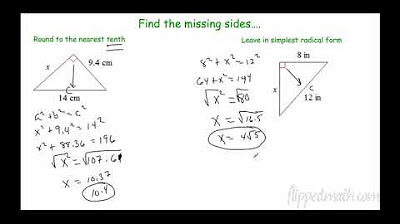Solving Two-Step Equations | Algebra Equations
Summary
TLDRIn the 'Math with Mr. J' video, the focus is on solving two-step equations. Mr. J demonstrates how to isolate variables by reversing operations, ensuring equation balance. Examples include undoing subtraction and division to isolate 'x' in '2x - 6 = 10', leading to x = 8, and 'R/5 + 8 = 11', resulting in R = 15. The video also covers handling parentheses and variables on different sides of the equation, emphasizing the importance of checking solutions in the original equations.
Takeaways
- 🔢 The main goal in solving equations is to isolate the variable.
- ⚖️ To maintain balance, whatever operation is done to one side of the equation must be done to the other side.
- 🔄 The process involves reversing the order of operations to isolate the variable.
- ➕ To eliminate subtraction on one side, add the opposite on both sides.
- ➗ To remove multiplication, use division as the opposite operation.
- 🔄 For equations like '2x - 6 = 10', first add 6 to both sides to eliminate the subtraction, then divide by 2 to solve for x.
- 🔄 In equations with division and addition, such as 'r/5 + 8 = 11', subtract 8 from both sides first, then multiply by 5 to solve for r.
- 🔄 When the variable is on the right side, like in '7 = 16 - 3e', subtract the constant from both sides to move the variable to the left.
- 🔄 Parentheses can be handled by dividing both sides by the coefficient outside the parentheses to simplify the equation.
- 🔄 Always check the solution by plugging the isolated variable back into the original equation to ensure accuracy.
Q & A
What is the main goal when solving equations with variables?
-The main goal is to isolate the variable, getting it by itself to solve the equation.
Why is it important to perform the same operation on both sides of an equation?
-It is important to perform the same operation on both sides to keep the equation balanced.
In the first example, what is the first step to isolate the variable 'x'?
-The first step is to add 6 to both sides of the equation to eliminate the subtraction of 6 on the left side.
How does adding 6 to both sides of the equation 2x - 6 = 10 help in solving for x?
-Adding 6 to both sides results in 2x = 16, which simplifies the equation and brings us closer to isolating x.
What is the reverse operation of multiplication used in the script?
-The reverse operation of multiplication is division, which is used to isolate the variable by making the coefficient equal to 1.
For the equation R / 5 + 8 = 11, how do you reverse the operation of addition?
-To reverse the addition, you subtract 8 from both sides of the equation to isolate the term with the variable R.
What is the purpose of multiplying both sides of an equation by 5 when solving for R in the equation R / 5 + 8 = 11?
-Multiplying both sides by 5 reverses the division by 5, which helps to isolate the variable R.
In the equation 7 = 16 - 3e, how do you handle the negative sign in front of the variable?
-You divide both sides by -3 to isolate the variable e, reversing the multiplication by -3.
Why is it necessary to divide both sides by 2 in the equation 2(y - 8) = 24?
-Dividing both sides by 2 undoes the multiplication by 2 outside the parentheses, simplifying the equation to y - 8 = 12.
How does adding 8 to both sides of the equation y - 8 = 12 help in isolating y?
-Adding 8 to both sides cancels out the -8 on the left side, leaving y by itself on the left side of the equation.
What is the final step to verify the solution to an equation?
-The final step is to plug the solution back into the original equation to see if it satisfies the equation and yields the correct result.
Outlines

This section is available to paid users only. Please upgrade to access this part.
Upgrade NowMindmap

This section is available to paid users only. Please upgrade to access this part.
Upgrade NowKeywords

This section is available to paid users only. Please upgrade to access this part.
Upgrade NowHighlights

This section is available to paid users only. Please upgrade to access this part.
Upgrade NowTranscripts

This section is available to paid users only. Please upgrade to access this part.
Upgrade NowBrowse More Related Video

The First Day of High School: Establishing Classroom Expectations and Building Relationships

Order of Operations: A Step-By-Step Guide | PEMDAS | Math with Mr. J

Jejak Matematika di Berbagai Budaya: Etnomatematika dalam Kehidupan Sehari-hari

(BOCORAN) SOAL TES MASUK SMP/MTs‼️PART 1

Lisa, wake up! - Conversation in English - English Communication Lesson

Geometry – 7.1 Pythagorean Theorem and Its Converse
5.0 / 5 (0 votes)